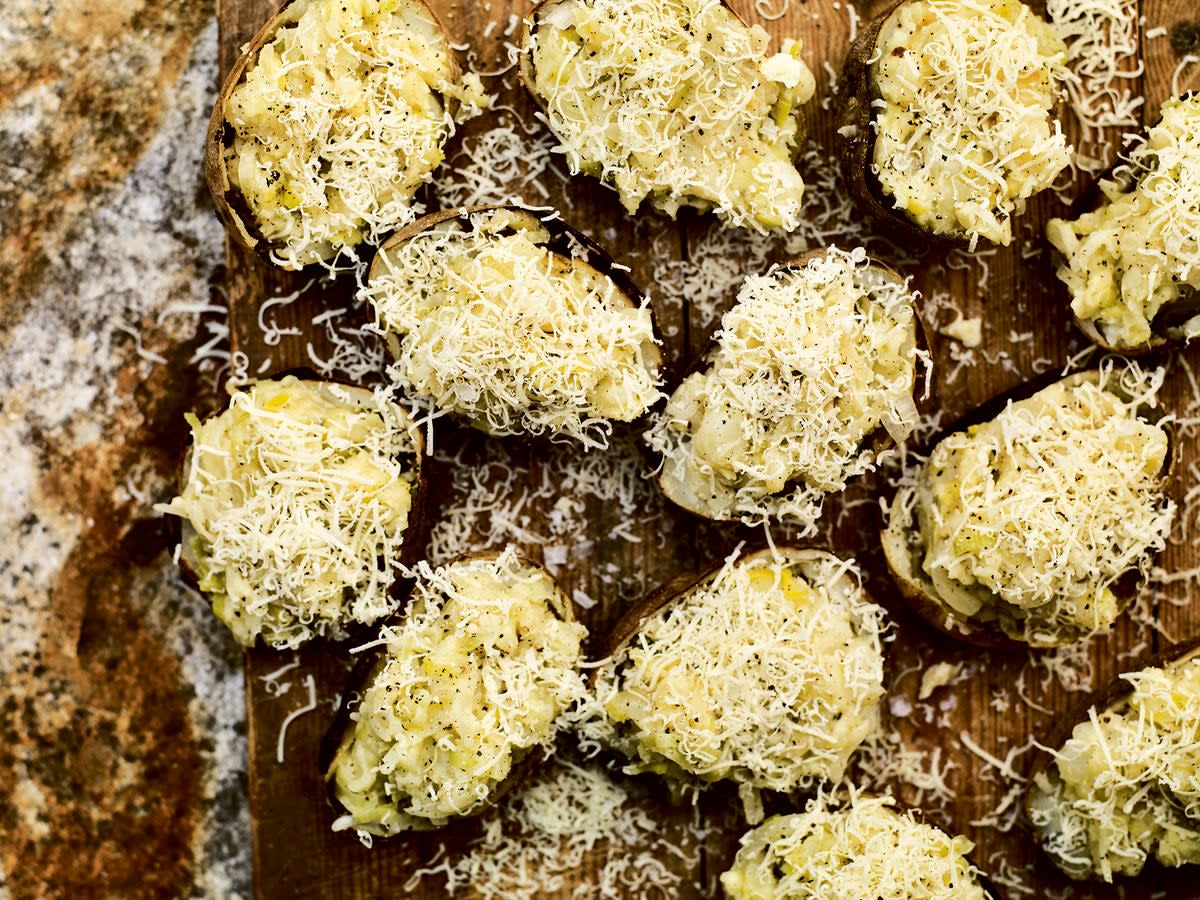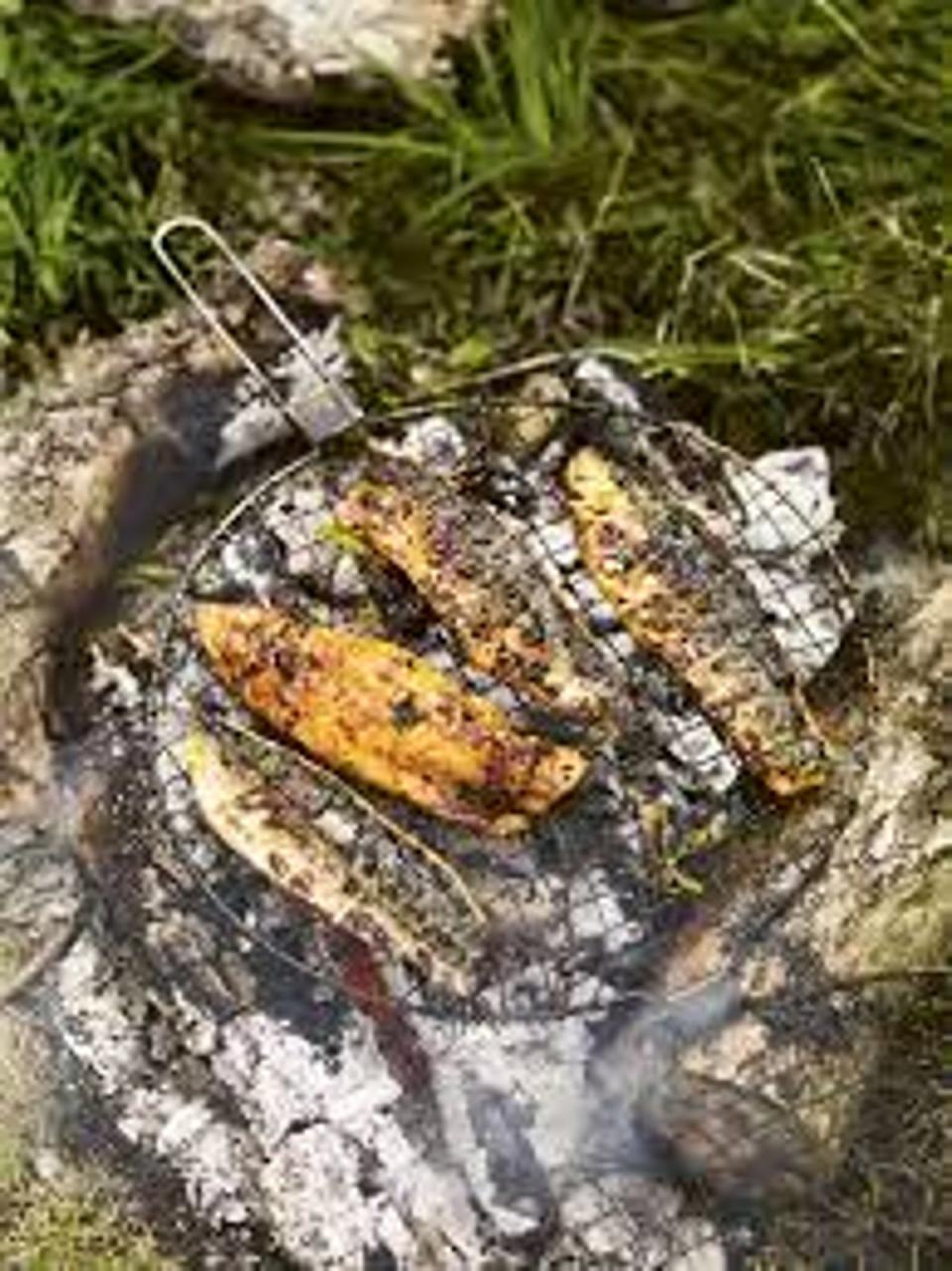Three outdoor recipes to help you reconnect with nature

Everyone loves baking potatoes in the embers of a fire, especially kids. It’s exciting for them to get involved,” says Gill Meller.
“Give them a stick, so they can prod and poke at the hot coals and roll their potatoes over when they need turning. While the spuds are cooking, get them to prepare the homity onions and leeks. It’s simple cooking, but they’ll learn so much from helping you.”
Homity baked potatoes
Serves: 4 or more
Ingredients:
8 baking potatoes
1 tbsp extra-virgin olive oil
150g butter
2 leeks, sliced into rounds
2 onions, halved and sliced
1 tbsp wholegrain mustard
100g mature cheddar, finely grated
Sea salt and freshly ground black pepper
Method:
1. You’ll need a big fire going for this recipe. Let the wood and charcoal burn back, so you have a broad bed of chunky embers. Make sure the coals aren’t too fierce otherwise the potatoes won’t cook evenly.
2. Give the potatoes a scrub, but only if they need it. Rub them all with extra-virgin olive oil and sprinkle them generously with salt and pepper. Wrap each potato in a double layer of foil. Use a pair of tongs to clear some potato-shaped hollows in the embers and nestle the spuds down into these gaps. Make sure they have a significant amount of heat surrounding them. You don’t need to cover them as such, just pile up the embers around their sides. Turn the potatoes every 10-15 minutes using your tongs, until they feel soft – about one hour.
3. Meanwhile, set a large pot over the fire and add one third of the butter. When it’s bubbling away, add the leeks and onions and season with some salt and pepper. Sizzle them, stirring regularly until they are soft and they smell lovely and sweet.
4. Unwrap the soft potatoes and cut them in half. Use a spoon to scoop out the middle of the flesh into the pot with the leeks and onions. Leave enough potato in the skins so as not to tear them. Add the remaining butter, the mustard, half the cheddar and season with some salt and pepper.
5. Mix everything together. You can leave it all quite chunky.
6. Pile the homity potato mix back into the jacket halves and scatter over the remaining cheese. Eat hot.
Grilled mackerel with lemon, smoked paprika, oregano and black pepper

“Summer wouldn’t be a thing without fresh mackerel. It’s a fish that has an undeniable affinity with smoky fires and searing coals – they seem drawn together,” says Meller.
“This is a particularly delicious way to cook fillets of mackerel or whole fish. The flavours I’m using are punchy, but the fish carry them all beautifully. I usually serve them with warm, crusty bread and a salad of ripe tomatoes and basil, dressed with salt, red wine vinegar and extra-virgin olive oil.”
Serves: 2
Ingredients:
2 tsp smoked paprika
1 tbsp extra-virgin olive oil
Finely grated zest of 1 lemon
2 garlic cloves, grated
A small handful of oregano, leaves picked and chopped
1 rosemary sprig, leaves picked and chopped
1 tbsp black peppercorns, crushed
4 very fresh mackerel fillets
Sea salt
Method:
1. Combine the smoked paprika with the oil, lemon zest, garlic, oregano, rosemary and peppercorns and season with salt.
2. Use the back of a spoon to spread the garlic mixture out over each fillet. Light your fire and when you have a bed of hot, glowing embers, set the mackerel fillets, skin-side down, on the grill. Cook for four to five minutes. You’ll notice the flesh change colour as it cooks. When the mackerel’s nearly done, turn the fillets and give them a further one minute on the other side.
3. Carefully lift the mackerel off the grill to a plate, and serve.
Campfire pork and beans

Meller says this recipe is “set somewhere between a cassoulet and Boston baked beans. It’s absolutely perfect for cooking round the campfire – rich, hearty and warming,” he adds. “You’ll need to get it going in the afternoon, and then let it simmer away gently, until dusk.”
Serves: 4
Ingredients:
250g dried haricot beans
1 tbsp sea salt
1 tbsp extra-virgin olive oil
200g bacon lardons or bacon off-cuts
3 celery sticks, cut in 2-3cm pieces
1 large onion, chopped
4 garlic cloves, thinly sliced
7-8 sage leaves, cut into ribbons
1 rosemary sprig, leaves picked and chopped
1 x 400g can of chopped tomatoes
1 tbsp light brown soft sugar
1 tbsp red wine vinegar
250g piece of smoked bacon
2-3 bay leaves
6-8 pork sausages
Freshly ground black pepper
Method:
1. Place the dried beans in a large bowl and cover them with water. Add the salt, give the beans a stir and allow them to soak for 10–12 hours or overnight. (If you’re camping, you may want to do this before you leave.)
2. Drain the beans and place them in a large pan. Cover with more water and set the pan over a hot fire. Bring the liquid to a simmer and cook until the beans are tender – about 45 minutes should do it.
3. Set a large, heavy-based saucepan, that has a lid, over a medium-hot fire.
4. Add the extra-virgin olive oil and, when it’s hot, add the bacon lardons and fry them until they take on a bit of colour and begin to render some of their fat. Now, add the celery, onion and garlic. Stir well and continue to cook for five to 10 minutes more. Add the sage and rosemary and some black pepper.
5. Stir in the canned tomatoes, sugar and red wine vinegar. Add the drained beans and about 500 millilitres of water, so the bacon and beans are covered. Tuck in the piece of smoked bacon and add the bay leaves. Put a lid on the pan and let it cook gently for two hours.
6. When it’s had its time simmering and the beans are meltingly tender, lay the sausages down on the grill over a medium-high heat. Cook them, turning regularly, until they are dark and caramelised, then add them to the stew. If they seem a bit too big, just cut them in half. Continue to cook the stew gently for 15–20 minutes, until the sausages are cooked through, then take it off the fire and let it rest and cool for at least 10–15 minutes before serving.
‘Outside: Recipes For A Wilder Way Of Eating’ by Gill Meller (published by Quadrille, £30; photography by Andrew Montgomery), available now.

 Yahoo News
Yahoo News 
